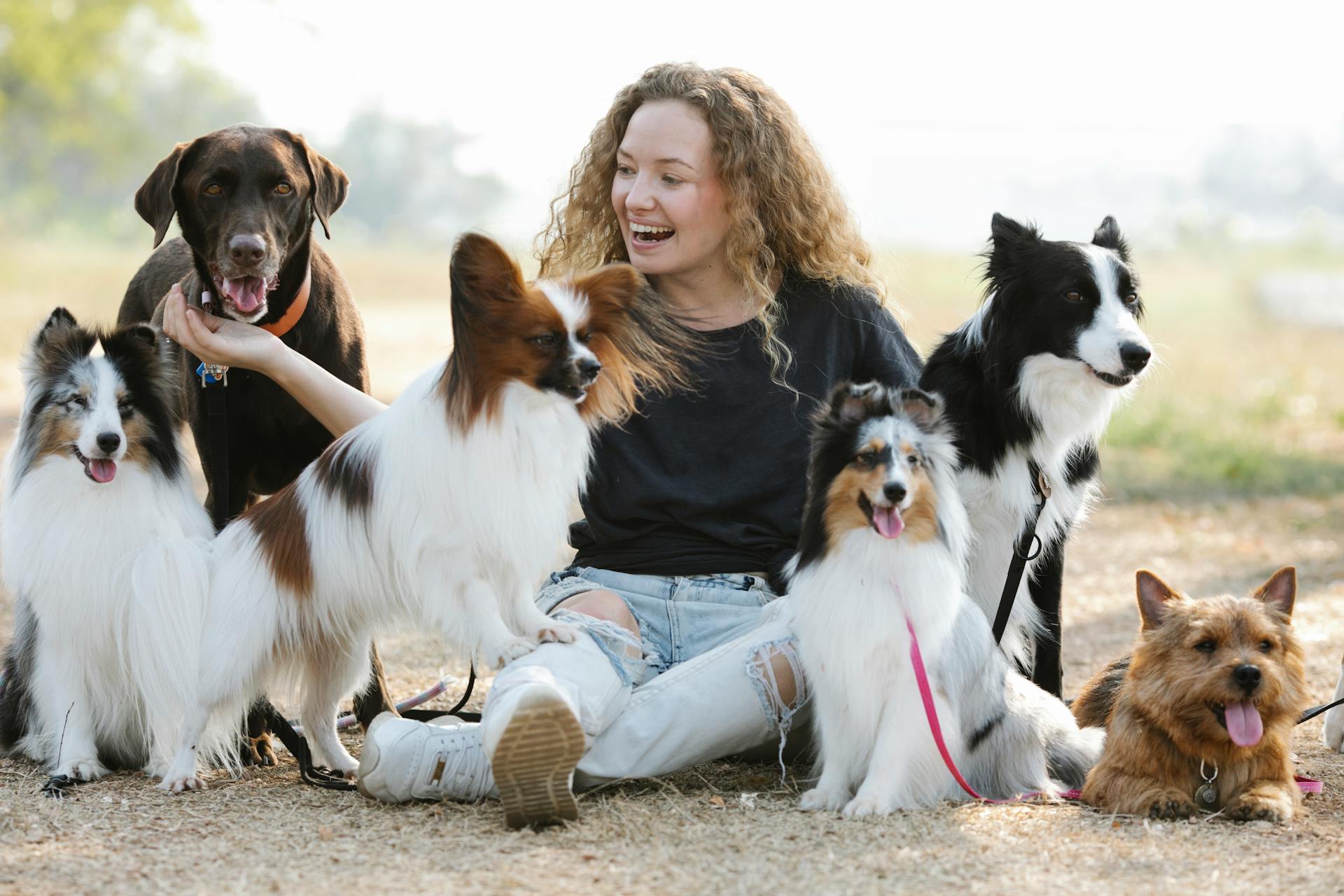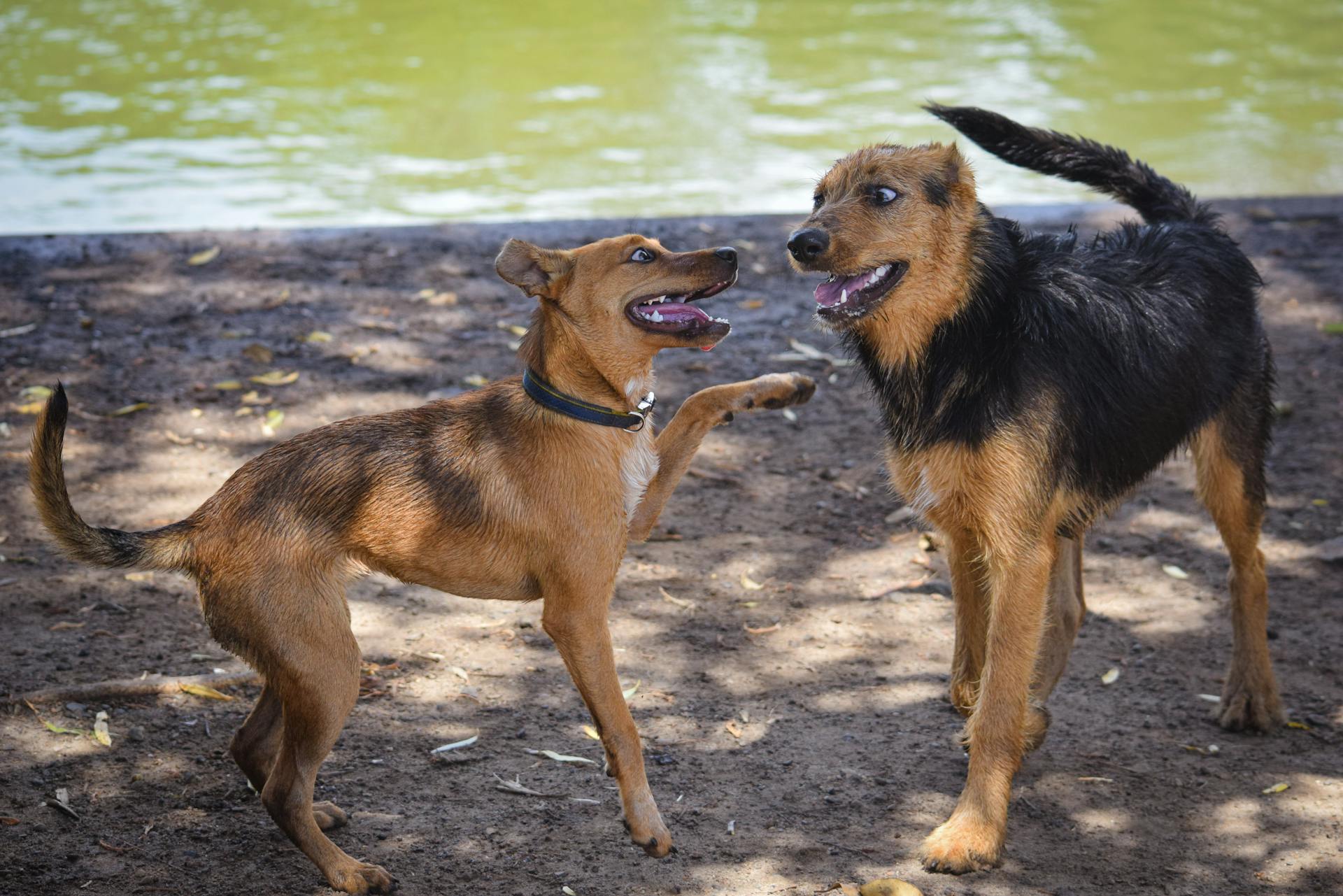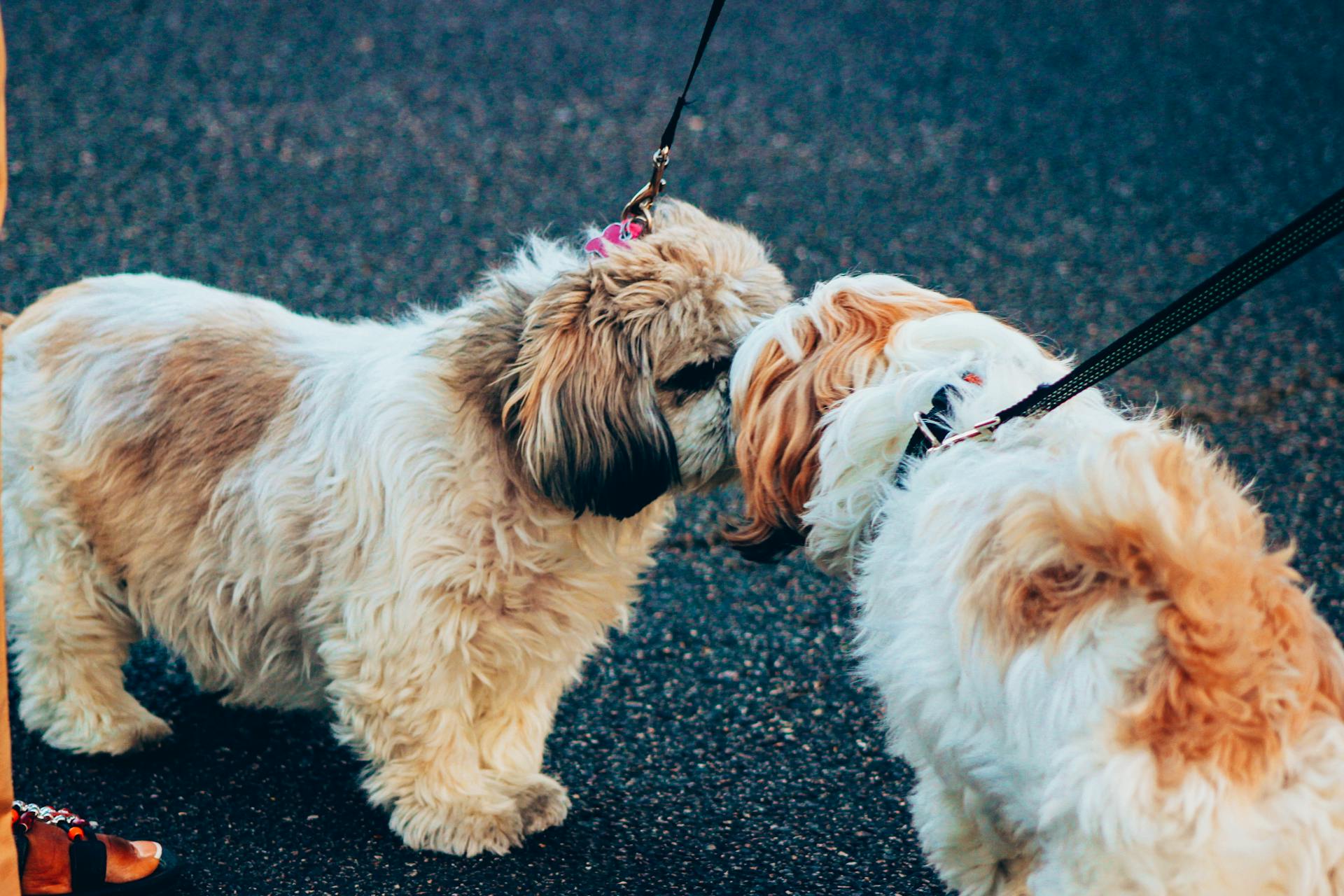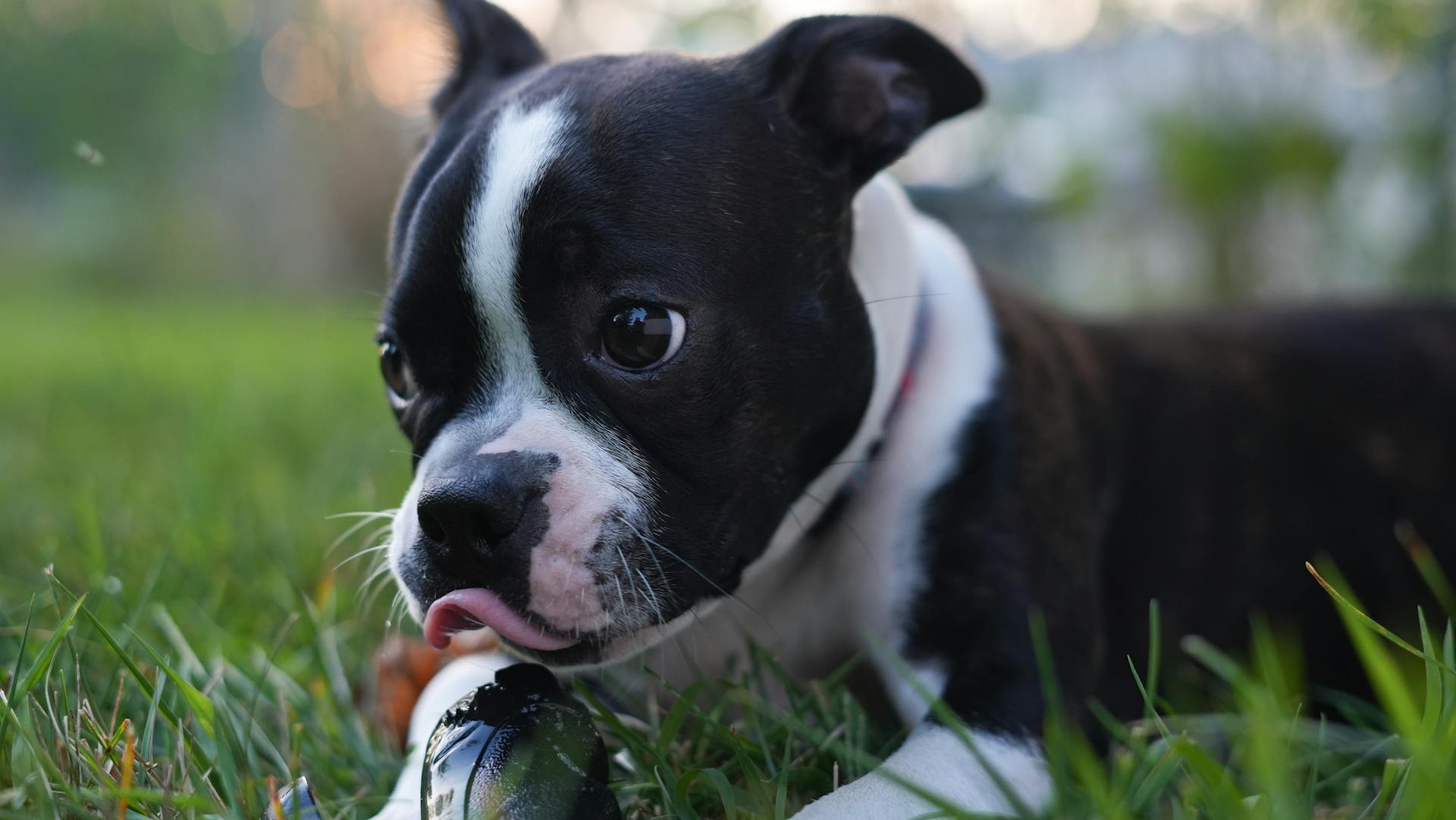
Dogs communicate with each other through body language, and it's essential to understand these cues to prevent conflicts.
A dominant dog will often stand over a subordinate dog, with their head held high and ears forward, signaling their status.
This behavior can be seen in multi-dog households where one dog has established dominance over the others.
Submissive dogs, on the other hand, will often lower their heads and tuck their tails, indicating they're yielding to the dominant dog.
If a dog feels threatened or scared, it may display a "submissive grin", where the corners of their mouth are pulled back, showing their teeth.
In a pack, dogs will often greet each other with a sniff and a wag of the tail, indicating friendly intentions.
However, if a dog is feeling aggressive, it may display a "hard stare", where it holds the other dog's gaze without blinking.
If this caught your attention, see: Shiba Inu Reaching 1 Cent
Body Language Basics
Dogs communicate primarily through body language cues, which serve as a key indicator of their emotional state and intentions.
A dog's tail wagging can signify different emotions depending on the context. A broad, high wag usually indicates happiness, while a low, slow wag might suggest uncertainty or caution.
Dogs use their facial expressions to communicate, and a relaxed mouth, bright eyes, and ears in their natural position typically indicate a happy and content dog.
A tense mouth, narrowed eyes, and flattened ears can signify discomfort or anxiety. Recognizing these nuances in body language can help you address your dog's needs effectively and enhance your communication with them.
A dog displaying a lowered body posture, tucked tail, and avoiding eye contact may be signaling feelings of fear or discomfort.
By paying attention to these subtle variations in body language, you can tailor your responses to better support your furry companion.
Worth a look: Dog with Bone in Mouth
Wagging and Position
Dogs often wag their tails to communicate positive feelings, especially when they're relaxed or excited to see their owner. Studies have shown that right-biased tail wagging, where the tail is biased to the right side of the body, is a common indicator of a happy or approachable dog.
A dog's body position can also give away their emotions. A standing, upright position can indicate dominance or aggression, while a withdrawn body position with weight distributed to the hind end suggests fear.
A crouched position with the front legs lower than the back legs can be a sign of higher aggression, often accompanied by other warning signs like snarling, a wrinkled nose, and raised hair along the back.
For your interest: Dogs Ears Back Tail Wagging
Left-Biased Wagging
Left-biased tail wagging is a behavior where a dog's tail wags more to the left side of their body, as viewed from the rear. This type of wagging is often associated with stress or anxiety in dogs.
Dogs that are presented with a conspecific displaying left-biased tail wagging behavior tend to be more stressed than those shown right-biased tail wagging. This increased emotional response suggests that left-biased tail wagging communicates negative feelings.
In the presence of an unfamiliar, dominant conspecific, dogs are more likely to display left-biased tail wagging. This behavior is a clear indication that the dog is feeling uneasy or threatened.
Dogs that are shown left-biased tail wagging are more likely to exhibit heightened cardiac activity and behavioral changes. This is a clear sign that the dog is under stress or anxiety.
You might like: How to Stop Separation Anxiety in Dogs
Position
A dog's body position can reveal a lot about its emotions. A standing, upright position can indicate dominance or aggression if the body is stiff.
A withdrawn body position with weight distributed to the hind end of a dog suggests fear. This is a clear sign that the dog feels uneasy or threatened.
A dog can alter its body position to show submission. Active submission is demonstrated by keeping the body low to the ground, while passive submission is demonstrated by lying on the ground with the underbelly exposed.
If a dog crouches down with the front legs lower than the back legs, it may be a sign of higher aggression. This position is often accompanied by other warning signs like snarling, a wrinkled nose, and raised hair along the dog's back.
Lowering the body or rolling onto the side can reveal submissiveness. This is a clear sign that the dog feels calm and relaxed.
Take a look at this: Why Does a Dog's Tail Wag
Aggression and Fear
A defensive aggression posture in dogs is a clear warning sign that they feel threatened and are trying to protect themselves. They'll lower their body, shift their weight backward, and possibly raise their hackles.
Dogs who feel threatened may avoid direct eye contact as a way of showing submission and defusing the situation. This is a common posture in dogs rescued from abusive or traumatizing situations.
A dog's teeth can also give away their emotions - if they're exposing all their teeth, it's a sign of defensive aggression.
Readers also liked: Are Zoomies a Sign of a Happy Dog
Appeasement
Appeasement is a way for your dog to show they're not a threat, often used to greet dogs or humans with a more dominant social status. It can be tricky to distinguish from fear, but looking at the full context of the situation can help.
A dog in an appeasement posture will often have their body low to the ground or rolled over, exposing their belly. This is a sign that they're trying to show submission.
Take a look at this: How Often Can You Put Flea Medicine on a Dog

Their ears will be low and close to their body, and may be stiff. This can be a sign that they're trying to appease, rather than showing fear.
A stiff tail that's low or between their legs, and possibly wagging rapidly, is another common appeasement posture. This can be a sign that they're trying to show friendliness, rather than aggression.
Tight lips and a tendency to start licking are also signs of appeasement. This is your dog's way of saying "I come in peace!"
Recommended read: Sign Language for Dog Training
Offensive Aggression
Offensive Aggression is a fascinating topic, and it's essential to understand the difference between offensive and defensive aggression in dogs.
An offensively aggressive dog will often stand tall, with a stiff body, and stiff, pricked-up ears.
Their tail will be held high, and they may display a raised lip, exposing just their front teeth, including incisors and canine teeth.
Direct eye contact is a common behavior in offensively aggressive dogs, often accompanied by barking or deep growling.
You might enjoy: Will Shiba Inu Coin Reach $1
Defensive Aggression
Defensive aggression is a common response in dogs that feel threatened or scared. A dog in a defensive posture will lower its body to the ground, shifting its weight backward.
Their ears will be stiff and tight against their head. This can be a sign that a dog is preparing to defend itself.
A defensive dog's tail will often be held high, a sign of tension and alertness. This is the opposite of a relaxed, wagging tail.
A dog exhibiting defensive aggression will likely avoid direct eye contact, instead giving clear warnings with deep barks or growls. This is a way for them to communicate their discomfort without escalating the situation.
Dogs that have been rescued from abusive or traumatizing situations may exhibit defensive aggression more frequently. This is a natural response to feeling threatened or scared.
Communication and Cues
Dogs communicate primarily through body language cues, which serve as a key indicator of their emotional state and intentions.
These cues can be divided into two categories: behavioral cues and holistic cues. Behavioral cues are specific movements involving body posture, ears, head/eyes, and tail, such as tail wagging. Holistic cues, on the other hand, are approximate evaluations of the observed overall state of the animal, including emotional and intentional cues.
Emotional cues describe a dog's feelings regarding a certain situation, such as fear or happiness. Intentional cues, expressed through body language, communicate the overall intention of the dog, such as initiating play.
Dogs use a variety of methods to communicate, including vocals, body language, and scent. Vocals include barks, growls, howls, whines, and whimpers. Body language encompasses body posture, facial expressions, and tail wags. Scent is used for communication with other dogs and animals, including pheromones, urine marking, butt sniffing, and ground scratching.
By paying attention to these cues, you can better understand your dog's emotional state and respond accordingly. For example, a broad, high tail wag usually indicates happiness, while a low, slow wag might suggest uncertainty or caution.
Here are some common body language cues to look out for:
By recognizing these nuances in body language, you can gain a deeper understanding of your dog's feelings and strengthen the bond between you.
Understanding Dog Language
Dogs communicate primarily through body language cues, which serve as a key indicator of their emotional state and intentions. Interpreting your dog's body language is essential for effective communication, building a strong bond, and ensuring their well-being.
A dog's body language can convey a range of emotions, from happiness to fear, and can be influenced by their environment and the people around them. For example, a dog that approaches you with a relaxed body posture, open mouth, and a gently wagging tail is likely feeling happy and excited to see you.
Dogs use various body parts to communicate, including their ears, eyes, mouth, and tail. For instance, a relaxed mouth, bright eyes, and ears in their natural position typically indicate a happy and content dog. Conversely, a tense mouth, narrowed eyes, and flattened ears can signify discomfort or anxiety.
Here are some key body language cues to look out for:
- Relaxed body posture
- Open mouth
- Gently wagging tail
- Relaxed ears
- Bright eyes
- Tense mouth
- Narrowed eyes
- Flattened ears
Eyes
Eyes are one of the most expressive features of a dog's face, and with a little practice, you can learn to read them like a pro. A dog's use of eye contact and eye movements can communicate emotions and intentions, such as aggression, especially when combined with body stiffness.
You might like: Why Are My Dog's Nails Splitting?
Prolonged eye contact or staring can be a sign of aggression in dogs, so it's essential to be aware of this cue. Avoiding eye contact, or looking down, is a submissive dog behavior.
Your dog's eyes can also tell you how they're feeling. If their eyes look average in size and shape, it's likely they're happy, relaxed, and at ease. On the other hand, widened, enlarged eyes can be a sign of stress or fright.
Here's a quick guide to help you decode your dog's eye language:
By paying attention to these subtle cues, you can better understand your dog's emotional state and respond accordingly.
Mouth
Dogs can express a range of emotions based on movements of the teeth and lips. In an aggressive dog, the lips curl back to expose clenched teeth, which warns others of their ferocity.
An open mouth showing unclenched teeth indicates that a dog is in a playful or relaxed mood. This is a clear sign that your furry friend is happy to play or hang out with you.
Pay attention to how your dog's mouth is positioned - it's a quick way to gauge their emotional state.
For another approach, see: Why Does My Puppy Lick My Older Dogs Mouth
Ears
Your dog's ears are one of their most expressive features, and they can tell you a lot about how your dog is feeling. By paying attention to their ear positions, you can get a better sense of their mood and intentions.
Dogs with floppy ears can still communicate with their ears, but breeds with drooping ears, cropped ears, or permanently erect ears are mostly or completely unable to use their ears to display emotions.
Pricked up or raised ears at the base can mean your dog is paying attention or interested in something. This is often a sign that they're excited or eager to respond to a command, like "treat" or "walk".
If your dog's ears are held back or tight against their head, it's a clear sign that they're feeling scared, anxious, or trying to appease you or another dog. This is a warning sign that you should take their feelings into account and give them some space.
Ears pricked forward typically indicate alertness or curiosity, while ears laid back against the head can signal fear, anxiety, or submission.
See what others are reading: Idiopathic Head Tremor in Dogs
Understanding Dog Language
Dogs communicate in a few different ways, including vocals, body language, and scent. Vocals include barks, growls, howls, whines, and whimpers. Dogs use their body language to convey emotions and intentions, including body posture, facial expressions, and tail wags.
A relaxed mouth, bright eyes, and ears in their natural position typically indicate a happy and content dog. Conversely, a tense mouth, narrowed eyes, and flattened ears can signify discomfort or anxiety. By observing these facial cues alongside body postures, you can gain a deeper understanding of your dog's feelings and strengthen the bond between you.
Dogs also use their tails to communicate, and the way they hold their tail can indicate their emotional state. A high, stiff tail may indicate arousal or aggression, while a low or tucked tail can suggest fear or anxiety. A happy tail, on the other hand, is loose and relaxed, wagging with large amplitude.
To better understand your dog's body language, it's essential to consider various contexts and situations. For example, if your dog approaches you with a relaxed body posture, open mouth, and a gently wagging tail, it likely indicates happiness and excitement to see you. Conversely, if your dog cowers with a tucked tail and avoids eye contact, they might be feeling anxious or fearful.
Recommended read: Anxiety in Dogs Body Language
Here are some key elements to pay attention to when reading tail wags:
- Location: Where is your dog holding their tail?
- Speed: How fast is the wag?
- Breadth/Distance: Are they wagging with short strokes or broad/wide strokes?
- Other Body Language Signals: What is the rest of their body language saying?
- Situation: Are they in a comfortable situation, or are they in a new/stressful situation?
By paying attention to these subtle variations in body language, you can tailor your responses to better support your furry companion.
Key Elements and Chart
To understand dog body language with other dogs, it's essential to pay attention to specific key elements. Location is crucial, as a dog holding their tail high can indicate high arousal, while a low or between-legs tail can suggest fear or anxiety.
The speed of the wag is also a vital sign. A slow and methodic wag can be a sign of relaxation, while a fast or nearly vibrating wag can indicate excitement or stress.
The breadth or distance of the wag is another important factor. A wag with small amplitude can be a sign of high arousal, while a wag with large amplitude can indicate happiness.
Other body language signals, such as ear position and posture, can also provide valuable information. For example, a dog with their ears back may be feeling anxious or fearful.
A unique perspective: Dog Food for High Energy Dogs
In certain situations, a dog may exhibit natural behaviors that can be misinterpreted as signs of arousal or aggression. For instance, some breeds, like huskies and shiba inus, naturally carry their tails high.
Here's a quick chart to help you remember the key elements of dog body language:
Keep in mind that some breeds may exhibit natural behaviors that can be misinterpreted, so it's essential to consider the overall context of the situation.
Training and Socialization
Proper training and socialization are essential for your dog's overall well-being and behavior. This is because they shape your dog's behavior, enhance their responsiveness, and adaptability to various environments.
Training helps establish clear communication between you and your dog, strengthening your bond. By teaching basic commands like sit, stay, and come, you can foster obedience and responsiveness.
Socialization exposes your dog to various stimuli, environments, and interactions, promoting adaptability and confidence. This helps prevent behavioral issues like fearfulness, aggression, or anxiety.
Through structured training sessions, dogs learn to obey commands promptly, exhibit desirable behaviors, and interact positively with their surroundings. For example, a dog can learn leash manners, recall commands, and how to greet people politely.
By introducing dogs to different social settings, other animals, and people, socialization helps them navigate the world around them comfortably. This leads to well-adjusted and sociable companions.
Interpreting canine social signals is crucial for understanding your dog's behavior and interactions. By recognizing and interpreting these initial social cues, you can better manage your dog's interactions and prevent potential conflicts.
For another approach, see: Are Dogs Social Animals
Reading Your Dog's Language
Reading your dog's language is like learning a new language, and it's essential to understand the nuances of their body language to communicate effectively.
A relaxed body posture, open mouth, and gently wagging tail typically indicate happiness and excitement to see you.
If your dog cowers with a tucked tail and avoids eye contact, they might be feeling anxious or fearful.
By paying attention to ear position, tail carriage, and facial expressions, you can significantly enhance your ability to interpret your dog's mood and comfort level accurately.
A perked-up ear, held high tail, and soft gaze while playing with a new toy typically signifies engagement and contentment.
Conversely, a lowered head, averted gaze, and tucked tail between their legs when meeting another dog might indicate submission or discomfort.
Consistent and positive reinforcement of behaviors aligned with your dog's body language is pivotal in fostering a harmonious relationship and enhancing communication with your pet.
Praising your dog and offering treats when they display relaxed body language and a wagging tail can reinforce their sociable behavior.
By linking positive experiences with specific body cues, you not only encourage desirable conduct but also create a supportive environment where your dog feels understood and valued.
Dogs often use their ears, eyes, mouth, and tail to express themselves, and by understanding these signals, you can better interpret their needs and emotions.
A broad, high wag typically indicates happiness, while a low, slow wag might suggest uncertainty or caution.
A relaxed mouth, bright eyes, and ears in their natural position typically indicate a happy and content dog.
Conversely, a tense mouth, narrowed eyes, and flattened ears can signify discomfort or anxiety.
Intriguing read: Black Mouth Cur Pitbull Mix Puppy
Sources
- https://en.wikipedia.org/wiki/Body_language_of_dogs
- https://post.bark.co/health/dog-body-language-guide/
- https://www.dogtopia.com/blog/reading-your-dogs-body-language/
- https://nexgard.com.au/pet-care/dog-care/dog-body-language
- https://www.offleashk9training.com/understanding-your-canine-companions-body-language/
Featured Images: pexels.com


